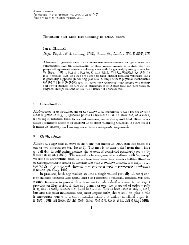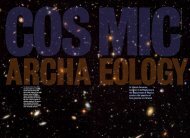Lecture Notes â Cosmology - UCL Astronomy Group
Lecture Notes â Cosmology - UCL Astronomy Group
Lecture Notes â Cosmology - UCL Astronomy Group
Create successful ePaper yourself
Turn your PDF publications into a flip-book with our unique Google optimized e-Paper software.
Ω M = 1 is a critical-density universe that will come to a halt after infinite time (and is geometrically flat;<br />
see below).<br />
If t 0 corresponds to the present age of the Universe, then for H 0 = 70 km/s Mpc −1 :<br />
Ω M = 0 gives t 0 = 1/H 0 ≃ 1.4 × 10 10 yr<br />
Ω M = 1 gives t 0 = (2/3)/H 0 ≃ 0.9 × 10 10 yr<br />
Ω M = 2 gives t 0 = 0.57/H 0 ≃ 0.8 × 10 10 yr<br />
Primordial nucleosynthesis and observational limits on the present-day deuterium abundance gives a limit<br />
on the baryon content, ρ B , of about 4% of ρ crit ; i.e, Ω B = 0.04.<br />
We know that there is also dark, non-baryonic, matter (recall: rotation curves of spiral galaxies, masses of<br />
clusters of galaxies). We believe that there is about 10 times as much dark as visible matter; i.e., in total,<br />
Ω M ≃ 0.3 from observations.<br />
For Ω M = 0.3, ρ M = 1.2 × 10 −27 kg m −3 .<br />
The energy density of 3 K cosmic background microwave radiation (CMB), expressed as a mass<br />
(E = mc 2 ), is ρ R = 4.5 × 10 −31 kg m −3 . (Stars contribute about the same radiation density – fewer<br />
photons, but each more energetic on average.)<br />
Because ρ M >> ρ R , the present-day universe is said to be matter dominated (although the number of<br />
photons exceeds the number of nucleons by a factor of about 10 9 ).<br />
In the early Universe, the reverse was true (radiation dilutes faster than matter, because radiation<br />
appears to lose energy by being red-shifted); the early Universe was radiation dominated.<br />
However, we have a potential problem – for Ω M > 0 (i.e., for a Universe that isn’t completely devoid of<br />
matter!), the implied age of the universe is less than the age of the oldest observed stars!<br />
Geometry of the Universe<br />
According to General Relativity, the geometry of space-time is also determined by the mass density (more<br />
properly, the mass–energy density) in the Universe. There are 3 possible geometries, determined by Ω,<br />
and related to the curvature parameter:<br />
• Ω > 1: the geometry is closed and spherical (the sum of the angles of a triangle > 180 ◦ ); k = +1.<br />
• Ω = 0: the geometry is open and hyperbolic (the sum of the angles of a triangle < 180 ◦ ); k = −1.<br />
• Ω = 1: the geometry is flat (Euclidean space, with the sum of the angles of a triangle = 180 ◦ );<br />
k = 0.<br />
Recent Results<br />
So what is the density parameter What is the future fate of the Universe Recent results give the<br />
surprising answers<br />
• Small-scale structure in the CMB<br />
The large-scale structure in the present-day universe (i.e., the distribution of galaxies in space; see<br />
later notes) can be mapped back to a prediction of the length scales of structure in the cosmic<br />
microwave background. Translating that linear scale into an observed angular scale depends<br />
sensitively on the geometry of space. Results from BOOMERanG and WMAP show that Ω (total)<br />
is within a few per cent of 1 – the Universe has a flat, Euclidean geometry.<br />
But we know, from primordial nucleosynthesis, that ordinary (baryonic) matter accounts for only<br />
Ω B ≃ 0.04, and all matter (baryonic plus ‘dark matter’) only Ω M ≃ 0.3. What makes up the other<br />
70% (since we know that radiation has a negligible role)<br />
• Supernova <strong>Cosmology</strong><br />
When we look at very distant galaxies, we see them as they were in the past. If gravity is slowing<br />
the rate of expansion of the universe, then in the past those galaxies were moving faster. If we can











